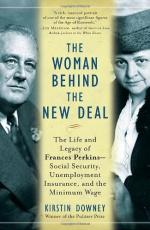|
This section contains 383 words (approx. 2 pages at 300 words per page) |
Encyclopedia of World Biography on Frances Perkins
Frances Perkins (1882-1965), American social worker, U.S. secretary of labor, and civil service commissioner, was the first woman to serve in a presidential Cabinet.
Frances Perkins was born in Boston, Mass., on April 10, 1882, and grew up in Worcester, the daughter of a manufacturer. At the age of 16 she entered Mount Holyoke College. Following her graduation in 1902, she spent 2 years in Worcester as a social worker for the Episcopal Church. She then taught school near Chicago before working at Hull House. After studying at the University of Pennsylvania's Wharton School of Finance, she took a master's degree at Columbia University in 1910.
Perkins next became executive secretary of the Consumers' League of New York, which investigated industrial conditions and lobbied for ameliorative legislation. In 1913 she married Paul Caldwell Wilson, a financial statistician, and they had one daughter.
Between 1919 and 1929, Perkins was industrial commissioner for the state of New York. She helped get further reductions of the work week for women, the publication of monthly figures on unemployment within the state, and other reforms. She was also active in immigrant education programs and won the confidence of both trade unionists and middle-class reformers. In 1929 newly elected governor Franklin D. Roosevelt made her labor commissioner of New York. Four years later she followed Roosevelt (now president) to Washington as secretary of labor, the first woman to hold a Cabinet appointment.
Although opposed by both business groups and the leadership of the American Federation of Labor (AFL) because of her sex and her liberal social and economic views, Perkins did a reasonably good job. Her department improved the operation of the Children's Bureau, began issuing regular unemployment figures, and contributed significantly to the standardization of state labor laws and the formulation of the Social Security Act. The Labor Department proved ineffectual in dealing with the industrial disturbances of the 1930s and with the strife between the AFL and the emergent Congress of Industrial Organizations (CIO).
Despite persistent, often harsh, criticism, Perkins stayed in office, resigning only after Roosevelt's death in 1945. Soon after, however, President Harry Truman appointed her to the U.S. Civil Service Commission. She served quietly and rather obscurely until she resigned in 1953. For the next 12 years Perkins lectured at Cornell University and other institutions. She died in New York City on May 14, 1965.
|
This section contains 383 words (approx. 2 pages at 300 words per page) |


